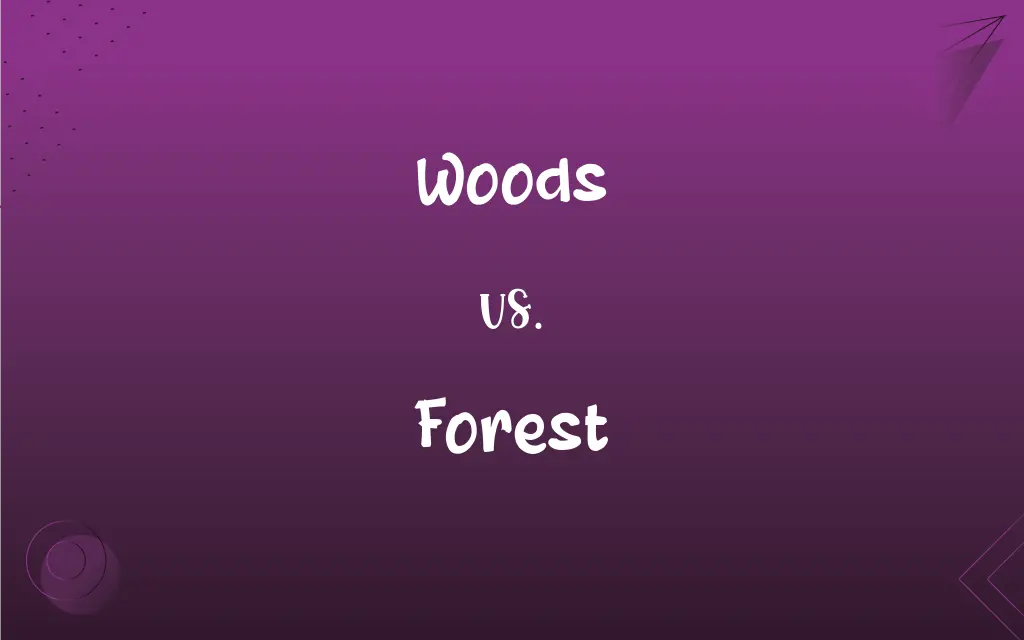Woods vs. Forest: What's the Difference?
Edited by Aimie Carlson || By Janet White || Published on January 26, 2024
Woods are smaller, less dense areas of trees, while forests are larger, more densely populated areas with a greater diversity of plant and animal life.

Key Differences
Woods refer to a smaller area covered with trees, often less dense and more accessible than forests. Forests, in contrast, are large ecosystems with a high density of trees, covering a vast area and often containing a diverse array of flora and fauna.
The woods are typically characterized by their smaller size and lesser tree density, making them ideal for recreational activities like hiking and bird watching. Forests, on the other hand, are expansive areas that can encompass various ecosystems, including rainforests and boreal forests, and play a crucial role in the Earth's climate and biodiversity.
Woods often have a more open canopy, allowing more sunlight to penetrate to the ground, supporting a different type of undergrowth compared to forests. Forests, with their denser canopies, create a unique environment underneath, often with less sunlight and a distinct set of understory plants and animals.
The term "woods" is often used to describe a cozier, more familiar woodland area, sometimes found near residential areas. Forests are typically thought of as more vast, wild, and untamed, often being the subject of conservation efforts due to their environmental importance.
In terms of biodiversity, woods may have a limited variety of species due to their smaller size, while forests, especially tropical rainforests, are known for their incredibly diverse and complex ecosystems.
ADVERTISEMENT
Comparison Chart
Size
Smaller, more contained areas
Larger, more expansive areas
Tree Density
Less dense, often with more space between trees
More densely populated with trees
Canopy
More open, allowing more sunlight
Denser, leading to a darker understory
Environment
Often near residential areas, used for recreation
More wild, diverse ecosystems, crucial for environment
Biodiversity
Less diverse due to size
Highly diverse, especially in tropical rainforests
ADVERTISEMENT
Woods and Forest Definitions
Woods
They often have a more open canopy and less dense tree coverage.
The sun filtered beautifully through the canopy of the woods.
Forest
Forests are large areas densely populated with trees and rich in biodiversity.
The Amazon Rainforest is one of the largest forests in the world.
Woods
Woods are a smaller area of land covered with a growth of trees.
We went for a walk in the woods behind our house.
Forest
They are crucial for the Earth's climate, air quality, and biodiversity.
Forests play a key role in absorbing carbon dioxide from the atmosphere.
Woods
Woods are typically more accessible and frequented for recreational activities.
Kids in the neighborhood often play games in the nearby woods.
Forest
Forests are often the focus of conservation efforts.
Conservationists are working hard to protect these ancient forests.
Woods
They can be part of a larger forest or stand alone.
The cottage was nestled in a small patch of woods.
Forest
Forests contain complex ecosystems, often with a closed canopy.
The forest's closed canopy creates a unique understory environment.
Woods
Woods provide habitat for various wildlife, though less diverse than forests.
We often see deer and rabbits in these woods.
Forest
They vary in types, including rainforests, boreal forests, and temperate forests.
Boreal forests cover vast areas of the northern hemisphere.
Woods
Plural of wood
Forest
A growth of trees and other plants covering a large area.
Woods
A dense collection of trees, usually one covering a relatively small area; usually smaller than a forest.
These woods are part of the Campbell property.
Forest
A large number of objects bearing a similarity to such a growth, especially a dense collection of tall objects
A forest of skyscrapers.
Woods
For chemical behavior purposes, trees in full leaf (coniferous or medium-dense deciduous forests).
Woods
The trees and other plants in a large densely wooded area
FAQs
Do woods have less biodiversity than forests?
Typically, yes, due to their smaller size.
Can woods be part of a forest?
Yes, woods can be a smaller part of a larger forest.
Are all forests densely populated with trees?
Generally, yes, forests are characterized by high tree density.
How big are woods typically?
They are smaller and more contained than forests.
What types of activities are common in woods?
Hiking, bird watching, and recreational walking.
Do woods provide habitat for wildlife?
Yes, they are home to various wildlife species.
Do forests vary in types across the world?
Yes, including rainforests, boreal, and temperate forests.
What is a forest's role in the environment?
Forests are crucial for climate regulation and biodiversity.
How does the canopy differ between woods and forests?
Woods often have a more open canopy, while forests have a denser one.
Are forests important for air quality?
Yes, forests play a vital role in air purification.
Are all forests protected by conservation efforts?
Many are, but not all forests are under protection.
Do woods play a role in local ecosystems?
Yes, they contribute to local biodiversity and ecosystems.
Can forests affect local and global weather patterns?
Yes, forests can influence both local and global climates.
Do forests contribute to the Earth's water cycle?
Yes, forests play a significant role in the water cycle.
Can both woods and forests be home to endangered species?
Yes, both can provide habitat for endangered species.
Are activities like logging more common in forests or woods?
Logging is more common in larger forests.
Are recreational activities in forests different from those in woods?
Yes, forests offer more extensive hiking, camping, and exploration.
Can woods be found near urban areas?
Yes, woods are often located near residential areas.
Are woods easier to navigate than forests?
Generally, yes, due to their smaller size and less dense growth.
Is the biodiversity in tropical forests higher than in temperate woods?
Yes, tropical forests typically have higher biodiversity.
About Author
Written by
Janet WhiteJanet White has been an esteemed writer and blogger for Difference Wiki. Holding a Master's degree in Science and Medical Journalism from the prestigious Boston University, she has consistently demonstrated her expertise and passion for her field. When she's not immersed in her work, Janet relishes her time exercising, delving into a good book, and cherishing moments with friends and family.
Edited by
Aimie CarlsonAimie Carlson, holding a master's degree in English literature, is a fervent English language enthusiast. She lends her writing talents to Difference Wiki, a prominent website that specializes in comparisons, offering readers insightful analyses that both captivate and inform.































































